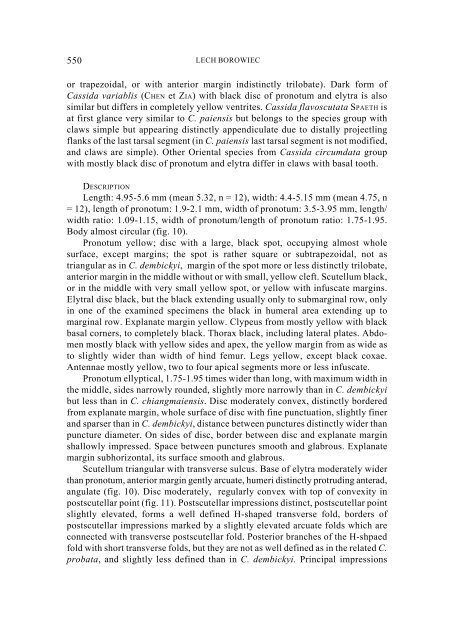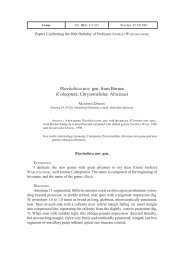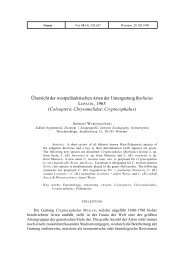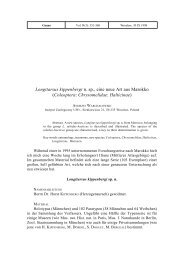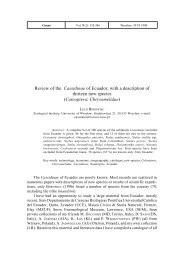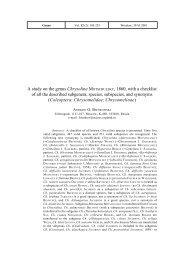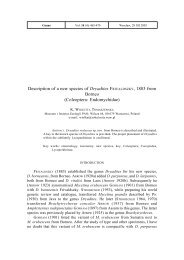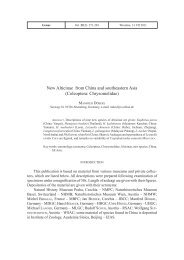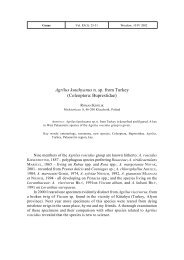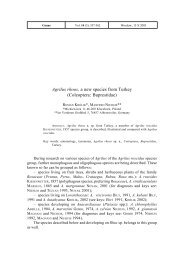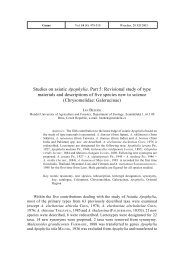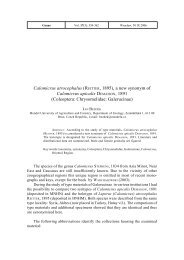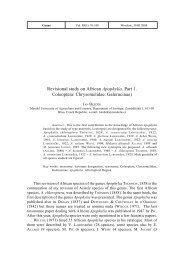New records of Asian and Australopapuan Cassidinae, with a ...
New records of Asian and Australopapuan Cassidinae, with a ...
New records of Asian and Australopapuan Cassidinae, with a ...
Create successful ePaper yourself
Turn your PDF publications into a flip-book with our unique Google optimized e-Paper software.
550<br />
LECH BOROWIEC<br />
or trapezoidal, or <strong>with</strong> anterior margin indistinctly trilobate). Dark form <strong>of</strong><br />
Cassida variablis (CHEN et ZIA) <strong>with</strong> black disc <strong>of</strong> pronotum <strong>and</strong> elytra is also<br />
similar but differs in completely yellow ventrites. Cassida flavoscutata SPAETH is<br />
at first glance very similar to C. paiensis but belongs to the species group <strong>with</strong><br />
claws simple but appearing distinctly appendiculate due to distally projectling<br />
flanks <strong>of</strong> the last tarsal segment (in C. paiensis last tarsal segment is not modified,<br />
<strong>and</strong> claws are simple). Other Oriental species from Cassida circumdata group<br />
<strong>with</strong> mostly black disc <strong>of</strong> pronotum <strong>and</strong> elytra differ in claws <strong>with</strong> basal tooth.<br />
DESCRIPTION<br />
Length: 4.95-5.6 mm (mean 5.32, n = 12), width: 4.4-5.15 mm (mean 4.75, n<br />
= 12), length <strong>of</strong> pronotum: 1.9-2.1 mm, width <strong>of</strong> pronotum: 3.5-3.95 mm, length/<br />
width ratio: 1.09-1.15, width <strong>of</strong> pronotum/length <strong>of</strong> pronotum ratio: 1.75-1.95.<br />
Body almost circular (fig. 10).<br />
Pronotum yellow; disc <strong>with</strong> a large, black spot, occupying almost whole<br />
surface, except margins; the spot is rather square or subtrapezoidal, not as<br />
triangular as in C. dembickyi, margin <strong>of</strong> the spot more or less distinctly trilobate,<br />
anterior margin in the middle <strong>with</strong>out or <strong>with</strong> small, yellow cleft. Scutellum black,<br />
or in the middle <strong>with</strong> very small yellow spot, or yellow <strong>with</strong> infuscate margins.<br />
Elytral disc black, but the black extending usually only to submarginal row, only<br />
in one <strong>of</strong> the examined specimens the black in humeral area extending up to<br />
marginal row. Explanate margin yellow. Clypeus from mostly yellow <strong>with</strong> black<br />
basal corners, to completely black. Thorax black, including lateral plates. Abdomen<br />
mostly black <strong>with</strong> yellow sides <strong>and</strong> apex, the yellow margin from as wide as<br />
to slightly wider than width <strong>of</strong> hind femur. Legs yellow, except black coxae.<br />
Antennae mostly yellow, two to four apical segments more or less infuscate.<br />
Pronotum ellyptical, 1.75-1.95 times wider than long, <strong>with</strong> maximum width in<br />
the middle, sides narrowly rounded, slightly more narrowly than in C. dembickyi<br />
but less than in C. chiangmaiensis. Disc moderately convex, distinctly bordered<br />
from explanate margin, whole surface <strong>of</strong> disc <strong>with</strong> fine punctuation, slightly finer<br />
<strong>and</strong> sparser than in C. dembickyi, distance between punctures distinctly wider than<br />
puncture diameter. On sides <strong>of</strong> disc, border between disc <strong>and</strong> explanate margin<br />
shallowly impressed. Space between punctures smooth <strong>and</strong> glabrous. Explanate<br />
margin subhorizontal, its surface smooth <strong>and</strong> glabrous.<br />
Scutellum triangular <strong>with</strong> transverse sulcus. Base <strong>of</strong> elytra moderately wider<br />
than pronotum, anterior margin gently arcuate, humeri distinctly protruding anterad,<br />
angulate (fig. 10). Disc moderately, regularly convex <strong>with</strong> top <strong>of</strong> convexity in<br />
postscutellar point (fig. 11). Postscutellar impressions distinct, postscutellar point<br />
slightly elevated, forms a well defined H-shaped transverse fold, borders <strong>of</strong><br />
postscutellar impressions marked by a slightly elevated arcuate folds which are<br />
connected <strong>with</strong> transverse postscutellar fold. Posterior branches <strong>of</strong> the H-shpaed<br />
fold <strong>with</strong> short transverse folds, but they are not as well defined as in the related C.<br />
probata, <strong>and</strong> slightly less defined than in C. dembickyi. Principal impressions


